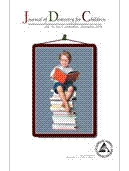
Pulpal and Periapical Response of Dogs' Teeth After Pulpotomy and Use of Recombinant Human Bone Morphogenetic Protein-7 as a Capping Agent
Objective: The purpose of this study was to evaluate the pulpal and periapical response of dogs' teeth after pulpotomy and the use of recombinant human bone morphogenetic protein-7 as a capping agent.
Methods: Pulpotomy was performed in 60 teeth from 6 dogs, and the remaining pulp tissue was capped with the following materials: (a) groups 1 and 5: recombinant human bone morphogenetic protein-7 associated with recombinant human-like collagen; (b) groups 2 and 6: recombinant human-like collagen; (c) groups 3 and 7: calcium hydroxide; and (d) groups 4 and 8: zinc oxide and eugenol cement. After 7 days (groups 1-4) and 70 days (groups 5-8), the animals were sacrificed and the pieces containing the teeth were removed and processed for histological analysis.
Results: Seven-day period: according to the type of inflammatory infiltrate observed in the root pulp tissue: (a) groups 1 and 2 were classified as severe with intense vascular proliferation; (b) group 4 was classified as moderate; and (c) group 3 was classified as mild. No dentin bridge formation was observed in any specimen, and the periapical region had normal appearance.
70-day period: groups 5, 6, and 8 showed no dentin bridge formation, and the remaining pulp tissue presented necrotic areas with inflammatory cells in the periapical region as well as bone and cemental resorption. In group 7, there was dentin bridge formation, absence of inflammation, and absence of mineralized tissue resorption.
Conclusion: The use of rHuBMP-7/rHuCollagen as a capping material after pulpotomy did not show either satisfactory apical and periapical response or capacity of inducing deposition of mineralized tissue.
Methods: Pulpotomy was performed in 60 teeth from 6 dogs, and the remaining pulp tissue was capped with the following materials: (a) groups 1 and 5: recombinant human bone morphogenetic protein-7 associated with recombinant human-like collagen; (b) groups 2 and 6: recombinant human-like collagen; (c) groups 3 and 7: calcium hydroxide; and (d) groups 4 and 8: zinc oxide and eugenol cement. After 7 days (groups 1-4) and 70 days (groups 5-8), the animals were sacrificed and the pieces containing the teeth were removed and processed for histological analysis.
Results: Seven-day period: according to the type of inflammatory infiltrate observed in the root pulp tissue: (a) groups 1 and 2 were classified as severe with intense vascular proliferation; (b) group 4 was classified as moderate; and (c) group 3 was classified as mild. No dentin bridge formation was observed in any specimen, and the periapical region had normal appearance.
70-day period: groups 5, 6, and 8 showed no dentin bridge formation, and the remaining pulp tissue presented necrotic areas with inflammatory cells in the periapical region as well as bone and cemental resorption. In group 7, there was dentin bridge formation, absence of inflammation, and absence of mineralized tissue resorption.
Conclusion: The use of rHuBMP-7/rHuCollagen as a capping material after pulpotomy did not show either satisfactory apical and periapical response or capacity of inducing deposition of mineralized tissue.
Keywords: CALCIUM HYDROXIDE; PULPOTOMY; RECOMBINANT HUMAN BONE MORPHOGENETIC PROTEIN -7; RECOMBINANT HUMAN-LIKE COLLAGEN; ZINC OXIDE AND EUGENOL CEMENT
Document Type: Research Article
Affiliations: Department of Pediatric Clinics, Preventive and Social Dentistry, School of Dentistry of Ribeirão Preto, University of São Paulo, Ribeirão Preto, São Paulo, Brazil. [email protected]
Publication date: 01 May 2007
- Acquired after the merger between the American Society of Dentistry for Children and the American Academy of Pediatric Dentistry in 2002, the Journal of Dentistry for Children (JDC) is an internationally renowned journal whose publishing dates back to 1934. Published three times a year, JDC promotes the practice, education and research specifically related to the specialty of pediatric dentistry. It covers a wide range of topics related to the clinical care of children, from clinical techniques of daily importance to the practitioner, to studies on child behavior and growth and development. JDC also provides information on the physical, psychological and emotional conditions of children as they relate to and affect their dental health.
- Information for Authors
- Submit a Paper
- Subscribe to this Title
- Membership Information
- Information for Advertisers
- Ingenta Connect is not responsible for the content or availability of external websites
- Access Key
- Free content
- Partial Free content
- New content
- Open access content
- Partial Open access content
- Subscribed content
- Partial Subscribed content
- Free trial content